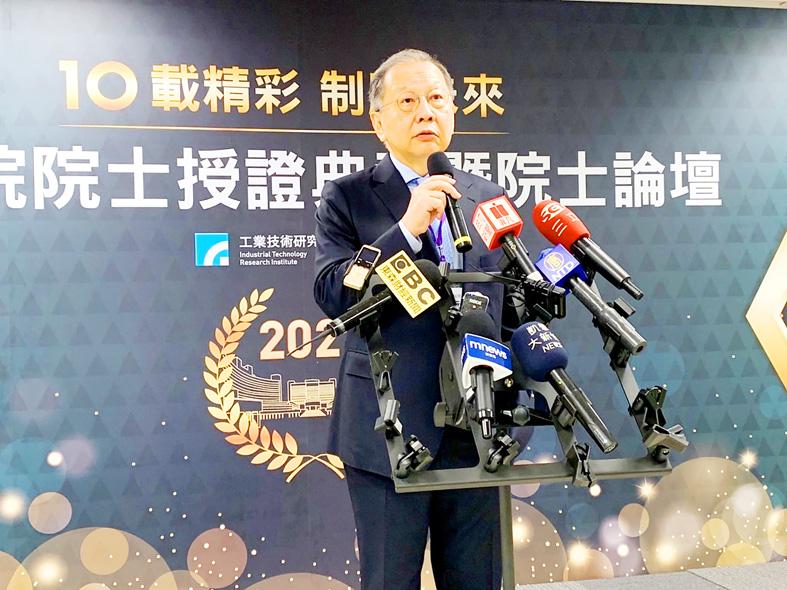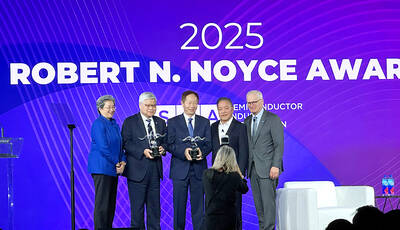MediaTek Inc (聯發科) yesterday said it would adopt next-generation 3-nanometer technology developed by Taiwan Semiconductor Manufacturing Co (TSMC, 台積電) for its new chips in a bid to consolidate its competitive edge.
The Hsinchu-based chip designer’s remarks came after speculation that Apple Inc might stick to 5-nanometer, rather than adopting TSMC’s 3-nanometer technology for its new iPhone series next year, due to unknown production problems.
TSMC has said that it is on track to increase production of 3-nanometer chips in the second half of next year.

Photo: Vanessa Cho, Taipei Times
MediaTek’s strategy is to enhance its competitiveness by collaborating with its major foundry partner, TSMC, a company executive said.
“We are not going to veer in a different direction... It is something we must do [to hold off the] competition,” MediaTek vice chairman and chief executive officer Rick Tsai (蔡力行) told a media briefing in Taipei.
“We have tapped 5-nanometer and 4-nanometer technologies to make our products. We think that 3-nanometer will certainly be next. We are working closely with TSMC,” Tsai said, declining to disclose a timeline.
MediaTek would further their cooperation by shifting to TSMC’s advanced chip packaging technology, dubbed chiplet, from existing 3D chip packaging technology.
Commenting on the lingering global chip shortage, Tsai said that supply next year would remain tight.
Tsai said that he does not expect to gain a clear picture of the supply-demand dynamics until 2023, when the world’s major foundries significantly ramp up new production.
For MediaTek, chip scarcity has been “manageable, but for the industry as a whole, it is a grave issue,” he said.
MediaTek last month told investors that it had a sufficient supply of chips to meet its business needs next year.
Given the company’s strong growth in 5G chips, Tsai said that MediaTek would be interested in using chips made at TSMC’s planned Kaohsiung factory.
TSMC’s board of directors approved the capacity expansion plan last week.
“The 5G market is growing beyond China next year, which will create a good opportunity for the company,” Tsai said.
MediaTek said that it expects to capture more than 35 percent of the Android-based smartphone market in North America.
The global 5G penetration rate next year is expected to exceed 50 percent, up from 30 percent this year, MediaTek added.

Shiina Ito has had fewer Chinese customers at her Tokyo jewelry shop since Beijing issued a travel warning in the wake of a diplomatic spat, but she said she was not concerned. A souring of Tokyo-Beijing relations this month, following remarks by Japanese Prime Minister Sanae Takaichi about Taiwan, has fueled concerns about the impact on the ritzy boutiques, noodle joints and hotels where holidaymakers spend their cash. However, businesses in Tokyo largely shrugged off any anxiety. “Since there are fewer Chinese customers, it’s become a bit easier for Japanese shoppers to visit, so our sales haven’t really dropped,” Ito

The number of Taiwanese working in the US rose to a record high of 137,000 last year, driven largely by Taiwan Semiconductor Manufacturing Co’s (TSMC, 台積電) rapid overseas expansion, according to government data released yesterday. A total of 666,000 Taiwanese nationals were employed abroad last year, an increase of 45,000 from 2023 and the highest level since the COVID-19 pandemic, data from the Directorate-General of Budget, Accounting and Statistics (DGBAS) showed. Overseas employment had steadily increased between 2009 and 2019, peaking at 739,000, before plunging to 319,000 in 2021 amid US-China trade tensions, global supply chain shifts, reshoring by Taiwanese companies and

Taiwan Semiconductor Manufacturing Co (TSMC, 台積電) received about NT$147 billion (US$4.71 billion) in subsidies from the US, Japanese, German and Chinese governments over the past two years for its global expansion. Financial data compiled by the world’s largest contract chipmaker showed the company secured NT$4.77 billion in subsidies from the governments in the third quarter, bringing the total for the first three quarters of the year to about NT$71.9 billion. Along with the NT$75.16 billion in financial aid TSMC received last year, the chipmaker obtained NT$147 billion in subsidies in almost two years, the data showed. The subsidies received by its subsidiaries —

Taiwan Semiconductor Manufacturing Co (TSMC) Chairman C.C. Wei (魏哲家) and the company’s former chairman, Mark Liu (劉德音), both received the Robert N. Noyce Award -- the semiconductor industry’s highest honor -- in San Jose, California, on Thursday (local time). Speaking at the award event, Liu, who retired last year, expressed gratitude to his wife, his dissertation advisor at the University of California, Berkeley, his supervisors at AT&T Bell Laboratories -- where he worked on optical fiber communication systems before joining TSMC, TSMC partners, and industry colleagues. Liu said that working alongside TSMC